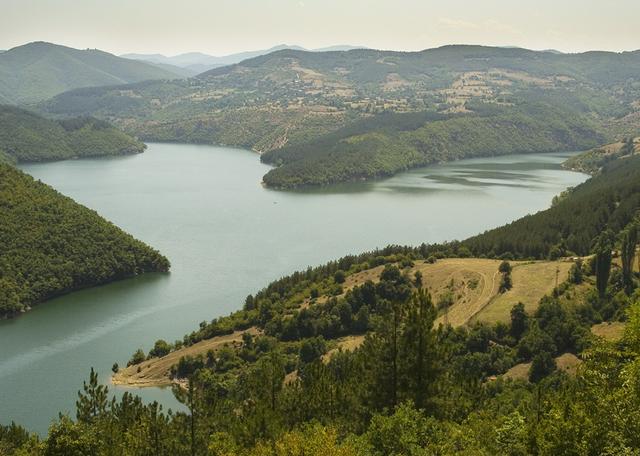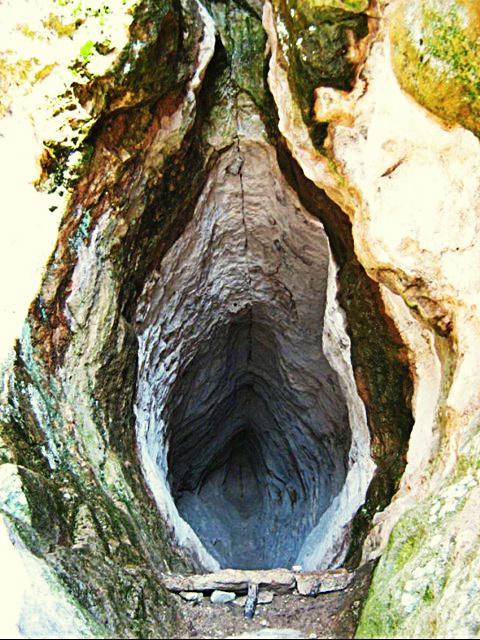Kardzhali, also Kurjali, Kurdjali, Karjali, Kardjali, Kardschali or Kurdzhali (Bulgarian: Кърджали), is a city in The Rhodopes, Bulgaria.
 The climate is somewhat similar to the Mediterranean countries which isn't surprising since it is only 35 miles from Greece and Turkey. The landscape is one of mountains and forests of oak and pine. The population of Kardzhali is mixed with 50% Bulgarians and 50% Turkish. Both languages are spoken.
The climate is somewhat similar to the Mediterranean countries which isn't surprising since it is only 35 miles from Greece and Turkey. The landscape is one of mountains and forests of oak and pine. The population of Kardzhali is mixed with 50% Bulgarians and 50% Turkish. Both languages are spoken.
 The region around Kardzhali has numerous ancient sites. Make sure to see the ancient city and fortress Perperikon, the temple and tomb at Tatul and the artificial astronomic cave near the village of Illinica.
There isn't much to see in city of Kardzhali. Don't miss to visit the local history museum, the fruit market and Kardzhali dam.
The region around Kardzhali has numerous ancient sites. Make sure to see the ancient city and fortress Perperikon, the temple and tomb at Tatul and the artificial astronomic cave near the village of Illinica.
There isn't much to see in city of Kardzhali. Don't miss to visit the local history museum, the fruit market and Kardzhali dam.
- Perperikon. The ancient Thracian town of Perperikon is located in the Eastern Rhodopes, about 15 km northeast of the Kardzhali on a 470 m high rocky hill, which is thought to have been a sacred place. The village of Gorna Krepost ("Upper Fortress") is located at the foot of the hill and the gold-bearing Perpereshka River flows near it. Perperikon is the largest megalith ensemble in the Balkans. It is thought that the famous Temple of Dionysius is located at this location.
- Tatul. The Thracian sanctuary is one of the most imposing megalithic monuments discovered on the territory of Bulgaria. The sanctuary is a massive rock structure and its top is a truncated pyramid. The complex comprises two sarcophagi, a rectangular bed for the main altar, and a three-metre-deep well. It dates back to the end of the 5th and the beginning of the 4th centuries BC.
- The Womb cave. This Thracian megalith - The Womb Cave (Cult complex “Utroba cave” Тракийско светилище Пещера Утроба) is located near village of Ilinica. The temple is shaped like the opening to a vagina. It leads into a 22 m deep cave. At the end of the cave, a carved altar (1.3 in height) symbolises the womb itself. At midday as the sun approaches its highest point, the sun light seeps into the cave through a special opening in the ceiling and projects a perfectly recognisable representation of a phallus onto the floor. As the sun progresses further, and the light slants across the interior of the cave, the phallus grows longer, reaching out to the womb altar. Only during some months of the year, when the sun is lowest on the horizon, the phallus becomes long enough to reach the altar and symbolically fecundate the womb. A well marked tourist route exists through Enchec village and around 300m after mountain cottage “Borovica”. The way to the cave includes around an hour of walking up. The path is steep but with three big alcoves and a shelter right under the cleft of the cliff. Local people know the place as Dangardak kaya (The echoing stone). Today childless couples visit the Womb cave to gain a long-awaited child.
- Fotinovo Turtles. Turtle-like reliefs, cut in the rocks by an ancient culture. Largest is 7 by 5 m.
Perperikon. The ancient Thracian town of Perperikon is located in the Eastern Rhodopes, about 15 km northeast of the Kardzhali on a 470 m high rocky hill, which is thought to have been a sacred place. The village of Gorna Krepost ("Upper Fortress") is located at the foot of the hill and the gold-bearing Perpereshka River flows near it. Perperikon is the largest megalith ensemble in the Balkans. It is thought that the famous Temple of Dionysius is located at this location.
Tatul. The Thracian sanctuary is one of the most imposing megalithic monuments discovered on the territory of Bulgaria. The sanctuary is a massive rock structure and its top is a truncated pyramid. The complex comprises two sarcophagi, a rectangular bed for the main altar, and a three-metre-deep well. It dates back to the end of the 5th and the beginning of the 4th centuries BC.
The Womb cave. This Thracian megalith - The Womb Cave (Cult complex “Utroba cave” Тракийско светилище Пещера Утроба) is located near village of Ilinica. The temple is shaped like the opening to a vagina. It leads into a 22 m deep cave. At the end of the cave, a carved altar (1.3 in height) symbolises the womb itself. At midday as the sun approaches its highest point, the sun light seeps into the cave through a special opening in the ceiling and projects a perfectly recognisable representation of a phallus onto the floor. As the sun progresses further, and the light slants across the interior of the cave, the phallus grows longer, reaching out to the womb altar. Only during some months of the year, when the sun is lowest on the horizon, the phallus becomes long enough to reach the altar and symbolically fecundate the womb. A well marked tourist route exists through Enchec village and around 300m after mountain cottage “Borovica”. The way to the cave includes around an hour of walking up. The path is steep but with three big alcoves and a shelter right under the cleft of the cliff. Local people know the place as Dangardak kaya (The echoing stone). Today childless couples visit the Womb cave to gain a long-awaited child.
Fotinovo Turtles. Turtle-like reliefs, cut in the rocks by an ancient culture. Largest is 7 by 5 m.
Go to Kardzhali dam. It is very high (about 120 meters) and it looks marvellous.
In the centre are three big supermarkets and many specialist shops. Also the fruit market is worth visiting.
Be sure to try their Turkish Biurek (Бюрек), which is something like Banitza. Of course there are many good restaurants offering good food. At least you can always go and eat a pizza.
In the dam lake there are also ship restaurants where customers can choose living fish for their meals.
- Komotini. in Greece
- Plovdiv. (Пловдив)
- Stara Zagora. (Стара Загора) . Getting out is as easy as getting in Kardzhali. There are about 15 buses leaving to Sofia, especially in the morning, so getting out is not a thing to worry about.
Komotini. in [[Greece]]
Plovdiv. (Пловдив)
Stara Zagora. (Стара Загора) .
